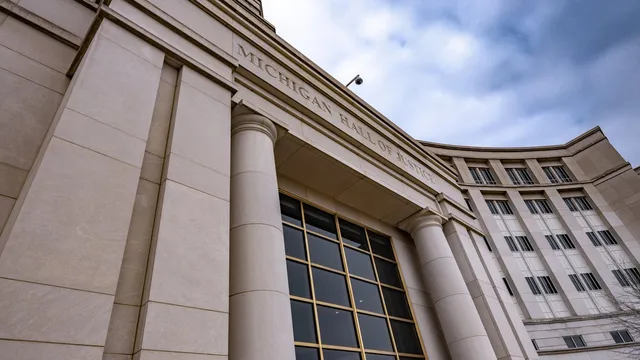
Michigan Supreme Court rules against life sentences for young murderers
2025-04-10 20:57- The Michigan Supreme Court ruled that mandatory life sentences without parole for 19 and 20-year-olds convicted of murder are unconstitutional.
- This decision allows hundreds of former offenders to seek reduced sentences based on their age and potential for rehabilitation.
- The ruling reflects a shift towards recognizing the developmental differences in young adults and raises challenges for victims' families.
Express your sentiment!
Insights
In a landmark ruling, the Michigan Supreme Court made significant alterations to the state's sentencing laws, particularly affecting those convicted of murder when they were 19 or 20 years old. This decision, announced on April 10, 2025, has permitted hundreds of individuals to return to court for reconsideration of their sentences, potentially leading to reduced terms and the possibility of parole. Mandatory life sentences that did not allow consideration of a young person's capacity for rehabilitation were deemed in violation of the Michigan Constitution's ban on cruel or unusual punishment. The court's opinion, which passed with a 5-2 majority, underscored a growing concern regarding the treatment of young offenders within the judicial system. Justice Elizabeth Welch articulated the court's view that a life sentence without parole disregards the developmental science suggesting that late adolescence is a crucial period for growth and change, where individuals become better equipped to understand the repercussions of their actions. This decision follows a similar ruling for individuals aged 18 and under in 2022, reflecting an ongoing shift in judicial philosophy towards recognizing the potential for rehabilitation in younger defendants. In light of this ruling, previously sentenced individuals may now appeal for new sentences, creating the potential for considerable changes in their lives. However, this reopening of cases is also expected to have emotional repercussions on the families of victims, as they will be drawn back into the judicial process to recount the pain and loss associated with the murders. Prosecutors will now bear the burden of proving why certain individuals should be ineligible for parole, ensuring that mitigating factors such as mental health, family backgrounds, and personal development are thoroughly examined. The dissenting opinion by Chief Justice Elizabeth Clement emphasized that such substantial changes to sentencing laws should originate from legislative bodies rather than judicial decisions influenced by scientific perspectives on youth behavior. As the Michigan Supreme Court adapts its interpretations of the law to align with evolving understandings of brain development and youthfulness, a broader conversation about justice, rehabilitation, and accountability continues to unfold in society. Stakeholders across various sectors, including legal, psychological, and community organizations, are now prompted to engage with these critical issues surrounding the treatment of young offenders in the context of violent crimes.
Contexts
The impact of prison sentences for young offenders in the US is a complex issue that requires careful examination of legal, social, and psychological factors. In recent years, the juvenile justice system has faced growing scrutiny over the effectiveness and consequences of incarceration for young individuals. Critics argue that prison sentences often fail to rehabilitate young offenders and can instead exacerbate issues such as recidivism, mental health problems, and social stigma. Research indicates that young people who enter the adult prison system are more likely to re-offend compared to those who receive alternative forms of intervention, such as community service or educational programs. This highlights the urgent need for a re-evaluation of punitive approaches towards youth crime, emphasizing rehabilitation over incarceration. The age of criminal responsibility in the US varies by state, leading to disparities in how young offenders are treated under the law. In many instances, minors are charged as adults for serious offenses, resulting in lengthy prison sentences that do not account for their developmental stages. The adolescent brain is still maturing, which affects decision-making, impulse control, and the understanding of consequences. By imposing adult-level sentences on juveniles, the justice system may inadvertently ignore these critical developmental factors, thus failing to provide an appropriate response that could guide a young individual towards a more constructive path. Consequently, alternative sentencing options, such as restorative justice practices, are gaining attention as viable methods to address juvenile crime while fostering personal growth. Statistical evidence supports the notion that alternatives to incarceration can significantly benefit young offenders. Programs that focus on mentorship, education, and community involvement have shown promising results in reducing re-offending rates. One such program is the use of diversionary tactics, which divert young offenders from the traditional justice system and provide them with support tailored to their needs. Such interventions not only aim to address the root causes of criminal behavior, such as poverty and lack of access to education but also prioritize the reintegration of youth into society. Moreover, the costs associated with incarceration versus community-based interventions highlight a compelling argument for reform; the latter is often less expensive and yields better long-term outcomes for individuals and society at large. Finally, the impact of prison sentences for young offenders extends beyond the individuals involved; it affects families and communities as well. The stigma associated with incarceration can lead to fractured family relationships and diminished community trust. Furthermore, young offenders may have limited access to education and employment opportunities post-release, perpetuating a cycle of poverty and criminal behavior. In conclusion, a significant shift in the approach towards young offenders is essential. Policymakers, educators, and community leaders must collaborate to create systems that prioritize rehabilitation and support, fostering environments in which young individuals can learn from their mistakes and reintegrate successfully into society.